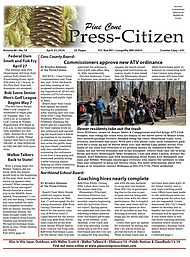April 22, 2023 at 3:25 p.m.
Outdoors - Tree planting
It is a well-known fact, deer and other wildlife prefer to eat or otherwise destroy store bought trees rather than native or volunteer ones. The speed at which the trees will be killed is directly proportional to the cost of the tree. I decided one day to get a weeping willow tree to plant down by the lake. There are hundreds of other wild willow trees in the area so I thought deer would probably leave this one alone. Just to insure my investment, after carefully planting, I built a six foot high chicken wire fence around the new tree, held firmly in place with steel posts. A few days later, I went down to water it and check on its general well-being. To my dismay, the chicken wire was strung out across the lawn, the steel posts were bent, and my new little willow tree was dead. What had not been used as a scratching post for some buck’s antlers was eaten down to a stump.
Being a slow learner, I soon thereafter purchased ten flowering pear trees. This was late in the tree planting season, and I got a really good deal on them. Since I did not have much invested in them, I thought my chances were better the deer would not destroy them. I was only partially correct. I planted seven near the cabin, gave two to my son, and put one on the island. Over the winter, the ones near the cabin were browsed by the deer back to the point where they looked like bushes rather than trees. The next spring, most of them were alive and started to thrive in their new locations. That fall, bucks mercilessly rubbed their antlers on them, killing five of the little pear trees. It is not like there is a shortage of trees on the farm to use as a rub, but these work much better for the deer as they are purchased trees. The only pear trees that remained unscathed were the ones in my son’s yard and the one on the island. His trees were not attacked as his dog keeps the deer out of his yard. The one on the island survived because the deer were not willing to swim to get to it.
Over the years, the flowering pear tree on the island has flourished. Each spring it puts forth a beautiful display of white flowers. The two survivors by the cabin are stunted and deformed but still are trying their best to live.
All seemed good with the tree on the island until late last fall. Driving by one day, I noticed a volunteer hickory tree was down. The next day, I saw a cedar tree was also down. I went over to the island to see what was going on and discovered a beaver had cut them down. I checked on my pear tree to find the beaver had also started on it. This meant war. With great timing, a neighbor kid stopped by and asked if he could do some trapping on the lake. I am not usually in favor of trapping for fear the dogs might get caught. This time, I made an exception. I explained about my beaver problem and showed him where it or they hang out on the far side of the lake. He apparently knows his craft as he caught a beaver within a few days.
From the house, with the spotting scope, I could see the damage at the base of my flowering pear tree on the island. After the beaver removal, the damage did not worsen but I wondered if the tree would make it. I was pleasantly surprised this spring when the tree again burst with loads of white flowers. It had been saved in the nick of time. Over the years, I have learned planting trees is a high-risk investment. There is always some form of wildlife that likes my trees as least as well as I do.

Comments:
You must login to comment.